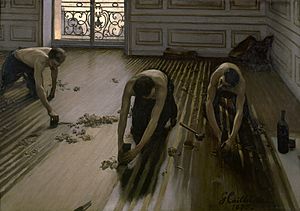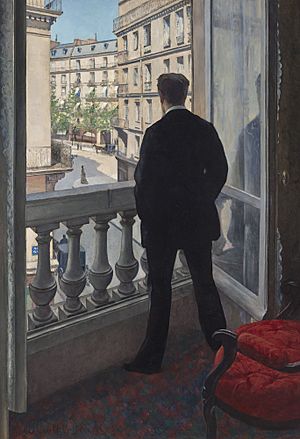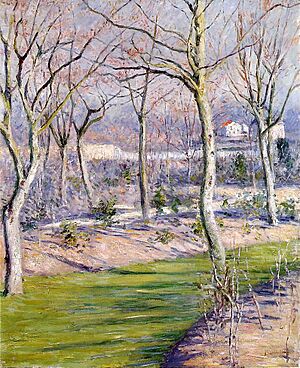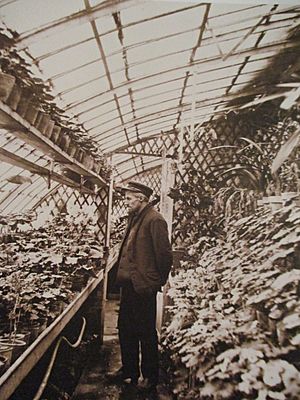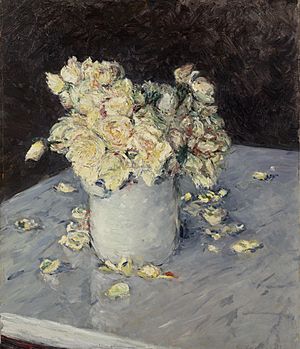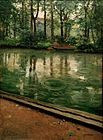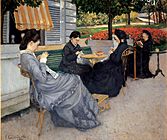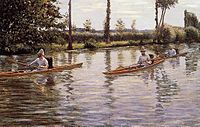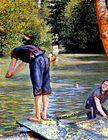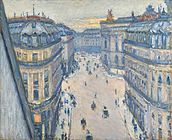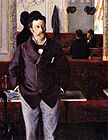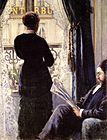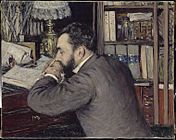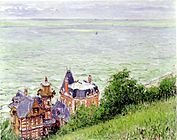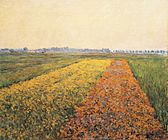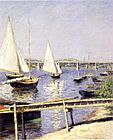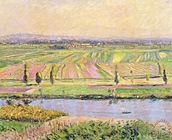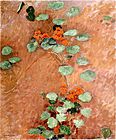Gustave Caillebotte facts for kids
Quick facts for kids
Gustave Caillebotte
|
|
|---|---|
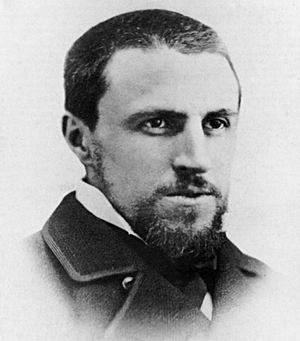
Gustave Caillebotte, about age 30, c. 1878
|
|
| Born |
Gustave Caillebotte
19 August 1848 Paris, France
|
| Died | 21 February 1894 (aged 45) Gennevilliers, France
|
| Nationality | French |
| Education | École des Beaux-Arts |
| Known for | Painting |
| Movement | Realism, Impressionism |

Gustave Caillebotte (born August 19, 1848 – died February 21, 1894) was a French painter. He was part of the famous Impressionist art group. Even though he was an Impressionist, his paintings often looked more realistic. Caillebotte was also very interested in photography as a new art form.
Contents
Gustave Caillebotte's Early Life
Gustave Caillebotte was born in Paris, France, on August 19, 1848. His family was wealthy. His father, Martial Caillebotte, owned a successful military textile business. He was also a judge. Gustave's mother was Céleste Daufresne. Gustave had two younger brothers, René and Martial.
The Caillebotte family lived in Paris. In 1860, they started spending summers in Yerres. This town is about 12 miles south of Paris. His father bought a large property there. Gustave probably started drawing and painting around this time.
Caillebotte studied law and became a lawyer in 1870. He was also an engineer. Soon after his studies, he joined the army. He fought in the Franco-Prussian War from 1870 to 1871.
Gustave Caillebotte's Artistic Journey
Becoming a Painter
After the war, Caillebotte started visiting the studio of painter Léon Bonnat. He began to study painting seriously. He quickly became a skilled artist. In 1873, he joined the École des Beaux-Arts, a famous art school. However, he did not spend much time there.
In 1874, Caillebotte inherited money from his father. After his mother died in 1878, he and his brothers shared the family fortune. Gustave and his brother sold the Yerres estate. They moved to an apartment in Paris.
Around 1874, Caillebotte met other artists. These artists did not follow the traditional rules of the Académie des Beaux-Arts. Among them were Edgar Degas and Giuseppe de Nittis. Caillebotte attended the first Impressionist art show in 1874. He did not show his own work there. The Impressionists were a new group of artists. They wanted to paint in a different way than the artists who showed their work in the yearly Salon exhibitions.
Caillebotte showed his paintings for the first time in the second Impressionist exhibition in 1876. He displayed eight paintings. One of them was Les raboteurs de parquet (The Floor Scrapers), painted in 1875. This painting showed workers scraping a wooden floor. Some art critics did not like this subject. They thought only peasants or farmers were suitable subjects from the working class. Because of this, the painting was rejected by the Salon in 1875. Today, this painting is at the Musée d'Orsay in Paris.
Caillebotte's Painting Style
Caillebotte wanted to paint reality as he saw it. He tried to make his paintings look less like a staged scene. His style changed a lot between his different works. It was as if he was trying out different ways of painting. Sometimes, his paintings looked very realistic, like those of Degas. Other times, he used softer colors and loose brush strokes, similar to Renoir and Pissarro.
Many of Caillebotte's paintings show a tilted ground. This might have been influenced by Japanese prints or the new art of photography. He also often "cropped" his scenes or "zoomed in." These techniques are common in photography. He was also very interested in how perspective works. Many of his paintings show scenes from a high viewpoint. Examples include View of Rooftops (Snow) (1878) and A Traffic Island (1880).
Common Themes in His Art
Caillebotte painted many scenes of home and family life. He often painted his family members. For example, Young Man at His Window (1876) shows his brother René. The Orange Trees (1878) shows his brother Martial and a cousin. Portraits in the Country (1875) includes his mother and other family members. He painted scenes of people eating, playing cards, playing piano, reading, and sewing. These paintings show the quiet, everyday life of wealthy families.
His country scenes at Yerres often show people boating, fishing, and swimming. He also painted scenes around his country home. For these paintings, he often used a soft, Impressionistic style. This style showed the peaceful feeling of the countryside. It was very different from the smooth style of his city paintings. In Oarsman in a Top Hat (1877), he painted a realistic view from inside a rowboat.
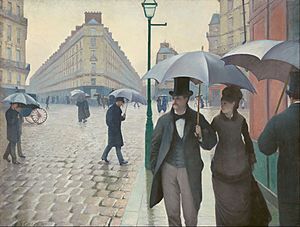
Caillebotte is most famous for his paintings of Paris city life. These include The Europe Bridge (1876) and Paris Street; Rainy Day (1877). Paris Street; Rainy Day looks very realistic, almost like a photograph. This gives it a unique and modern feel. Many of his city paintings were unusual because they used a very deep, plunging perspective. In Man on a Balcony (1880), he makes the viewer feel like they are on the balcony, looking out at the city. Other city paintings from the same time, like The Place Saint-Augustin (1877), were more Impressionistic.
Caillebotte also painted still lifes. These paintings mostly showed food, either on a table or in a butcher shop. He also painted some flower still-life paintings, especially in the 1890s.
Later Life and Legacy
In 1881, Caillebotte bought a property in Petit-Gennevilliers. It was on the banks of the Seine River. He moved there permanently in 1888. He stopped showing his paintings when he was 34 years old. Instead, he focused on gardening and building and racing yachts. He spent a lot of time with his brother Martial and his friend Auguste Renoir. Renoir often visited him. They had many discussions about art, politics, and other topics. Caillebotte was even a model for Renoir's painting, Luncheon of the Boating Party (1881). Caillebotte never married, but he had a serious relationship with Charlotte Berthier.
Caillebotte painted less in the early 1890s. He died in 1894 at age 45 from a lung problem. He was working in his garden at Petit-Gennevilliers when he passed away. He is buried in Père Lachaise Cemetery in Paris.
For many years, Caillebotte was known more for supporting other artists than for his own paintings. This was partly because he never had to sell his art to make a living. But about 70 years after his death, art experts started to look at his paintings again. His unique use of perspective made his work stand out. His art was largely forgotten until the 1950s. That's when his family started selling his collection. In 1964, the Art Institute of Chicago bought Paris Street; Rainy Day. This made Americans more interested in his work. By the 1970s, his paintings were being shown and studied again.
The National Gallery of Art in Washington, D.C., and the Kimbell Art Museum in Fort Worth, Texas, held a big show of Caillebotte's paintings in 2015–2016.
Supporting Other Artists
Caillebotte had a lot of money. This allowed him to paint without needing to sell his art. It also let him help pay for Impressionist exhibitions. He supported his artist friends like Claude Monet, Auguste Renoir, and Camille Pissarro. He bought their paintings and sometimes even paid their studio rent.
Caillebotte bought his first Monet painting in 1875. He was very helpful to Monet's career and helped him financially. He was careful about which artists he supported. He did not buy works by Georges Seurat or Paul Gauguin. In 1890, he helped Claude Monet get the French government to buy Édouard Manet's famous painting Olympia.
Other Hobbies and Interests
Caillebotte used his wealth to enjoy many hobbies. He loved collecting stamps, growing orchids, building and racing yachts. He even designed textiles. The women in his paintings Madame Boissière Knitting (1877) and Portrait of Madame Caillebotte (1877) might be working on patterns he created. After his death, he was recognized as a famous stamp collector. His stamp collection, which he built with his brother Martial, is now in the British Library.
Caillebotte's Art Collection
Caillebotte's younger brother René died in 1876. This made Gustave think his own life might be short. So, when he was still in his twenties, he wrote his will. In his will, Caillebotte left a large art collection to the French government. This collection included 68 paintings by famous artists:
- Camille Pissarro (19 paintings)
- Claude Monet (14 paintings)
- Pierre-Auguste Renoir (10 paintings)
- Alfred Sisley (9 paintings)
- Edgar Degas (7 paintings)
- Paul Cézanne (5 paintings)
- Édouard Manet (4 paintings)
When Caillebotte died, the Impressionists were still not fully accepted by the art world in France. He knew that his collection might end up forgotten. So, he said the paintings must be shown in the Luxembourg Palace (for living artists' work) and then in the Louvre. The French government did not want to agree to these terms.
In 1896, they finally made a deal with Renoir, who was in charge of Caillebotte's will. The government took 38 of the paintings for the Luxembourg Palace. This was the first time Impressionist paintings were shown in a public place in France. The remaining 29 paintings were offered to the French government again in 1904 and 1908, but they were refused both times. In 1928, the government tried to claim them, but the wife of Caillebotte's brother Martial Caillebotte refused. One of the remaining works, Bathers at Rest, was bought by Albert C. Barnes. It is now at the Barnes Foundation.
Today, 40 of Caillebotte's own paintings are at the Musée d'Orsay. His painting Man on a Balcony, Boulevard Haussmann (1880) sold for over $14.3 million in 2000.
Gallery
-
L'Yerres, effet de pluie (1875)
Eskenazi Museum of Art at Indiana University, Bloomington, Indiana -
Portraits à la campagne (1876)
Musée Baron Gérard, Bayeux -
Boating on the Yerres (1877)
Milwaukee Art Museum -
Les orangers (1878)
Museum of Fine Arts, Houston -
Rue Halévy, From the 6th Floor (1878), Museum Barberini, Potsdam -
Vue de toits (Effet de neige) (1878)
Musée d'Orsay, Paris -
Fruits sur un étalage (1882)
Museum of Fine Arts, Boston -
Portrait d'Henri Cordier (1883)
Musée d'Orsay, Paris -
Villas à Trouville (1884)
Cleveland Museum of Art -
The Yellow Fields at Gennevilliers (1884)
Lent to the Wallraf–Richartz Museum, Cologne -
Voiliers à Argenteuil (1888)
Musée d'Orsay, Paris -
La Plaine de Gennevilliers (1888)
Private collection
See also
 In Spanish: Gustave Caillebotte para niños
In Spanish: Gustave Caillebotte para niños



